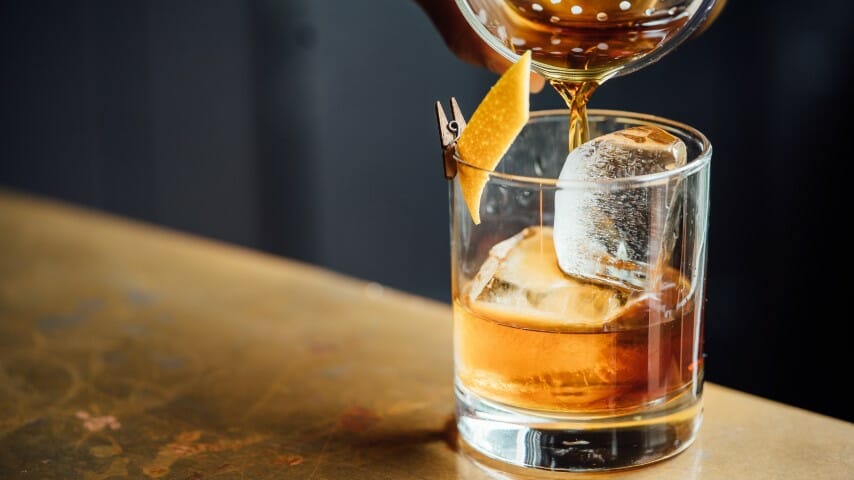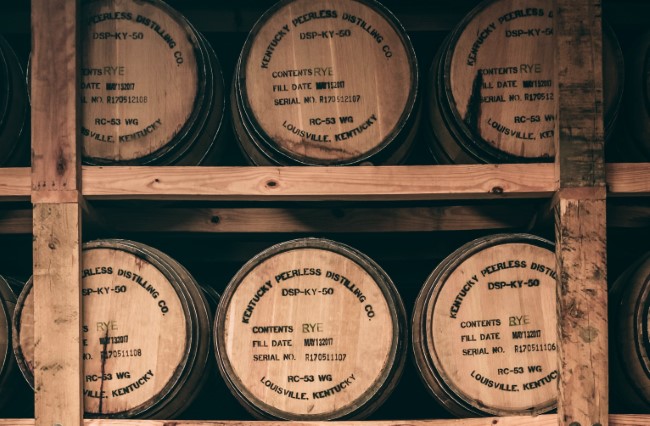Cocktail Queries: Is “Watering Down” Whiskey a Bad Thing? What Does Dilution Do?
Photo via Unsplash, Adam Jaime, Dylan de Jonge, Daniel Norris Drink Features bourbon
Cocktail Queries is a Paste series that examines and answers basic, common questions that drinkers may have about mixed drinks, cocktails and spirits. Check out every entry in the series to date.
When it comes to whiskey/whisky discussion, there are always a few particular arguments that are waiting to happen. One of the most perennially misunderstood? “Should I add water/ice to my whiskey?”
The concept and science of dilution, as it applies to whiskey, is something where the rank and file drinker can often be lacking education. They likely understand that adding a bit of water can help tame the fiery ethanol of stronger or “harsher” drams, but they’re not likely to understand what water really does to a spirit. And on a deeper level, it’s easy to be unaware of just how much water has been involved in the production process of your bourbon, rye, or scotch before you even uncork the bottle. Spoiler: There’s no such thing as “non-watered down” whiskey. It’s just a matter of when and how water was involved, but overall it’s safe to say that water itself is consistently the most misunderstood whiskey ingredient.
Therefore, let’s quickly summarize the role and effect of water on whiskey, both during production and after you crack open the bottle.
Dilution During Whiskey Production
Whiskey or whisky comes off the still at a variety of strengths in various countries, at different distilleries and in different styles, but the one constant is that this spirit doesn’t head straight into a barrel for aging. It’s simply too strong, too harsh and too unpalatable—you wouldn’t want to drink 160 proof bourbon, which is the legal maximum for initial distillation. In fact, a bourbon distilled to that level and then inserted into a barrel would likely end up even stronger after aging (due to water evaporation), and borderline undrinkable.
Of course, this wouldn’t be legally allowed in the U.S., anyway. Although bourbon can be distilled to a point as high as 160 proof, more grain-derived flavors and congeners (flavor compounds) are left in the spirit when the initial distillation proof is lower, closer to the 130-140 proof range. This is the level that most U.S. distilleries choose for their products. U.S. law then sets a maximum of 125 proof as the strongest level that whiskey can enter a barrel, meaning that an initial dilution with water is necessary at this point in order to bring the distilled spirit down to its barrel entry proof.
Note: 125 proof is the maximum level, and it’s the choice for many of the largest distilleries such as Jim Beam because it yields the most overall spirit per batch and is thus the most profitable way to do business. Many other distilleries, though, choose to put their spirit into barrels at a lower proof, believing that this results in better flavor extraction from the barrel while aging. Wild Turkey, for instance, uses a barrel entry proof of 115, while Maker’s Mark favors 110. Some smaller distilleries such as Peerless, meanwhile, go as low as 103 for barrel entry proof, but this is much more rare. These distilleries tend to tout low entry proof as a feature, because it’s significantly more expensive to make whiskey that way—because more water has been added prior to aging, they’re going to get less bottles of whiskey out of each barrel after the spirit is proofed down to its final level after aging.
 Water is actually an important component in drawing flavor out of a charred oak barrel.
Water is actually an important component in drawing flavor out of a charred oak barrel.
The science here contends that low entry proofs extract a more desirable flavor in part because water molecules are smaller than ethanol molecules—thus, they penetrate the wood more readily and draw those charred flavors back into the solution. Water also helps to deserve harsher phenolic compounds, which can contribute unpleasantly wood-dominated, tannic flavors in some whiskeys. And perhaps unexpectedly, the math also indicates that lower barrel entry proofs ultimately means you have to add less water overall to the spirit to bring it down to the desired final proof (usually 80-100 proof for standard whiskeys). This post explains the math nicely.
After aging in barrels, whiskey can be bottled at “cask strength”/“barrel proof,” but the majority of releases are then diluted once again to a final serving level that is bottled. Obviously, economic factors play in here—if you dilute the contents of a barrel to 80 proof, you get many more bottles than if you leave it at 115 or 120 proof. This is part of the reason why those higher proof whiskeys are typically more expensive.
This is all to say the following: By the time your whiskey reaches the bottle, it’s already been diluted with water at least once, and probably several times, in the pursuit of reaching the desired flavor profile.
Diluting Whiskey When Drinking
It feels a bit archaic now, but there are still whiskey communities and circles of discussion where you’ll find people espousing the idea that whiskey should never be diluted with water (or ice) when serving it. The idea here is that the “pure” spirit ought to be enjoyed all on its own, in neat drams, unadulterated by anything else.
This is of course a very limiting perspective, and one that ignores the obviousness of individual choice—you should of course consume your whiskey however you like it! That should go without saying, but there are also a few things to consider in terms of how additional water actually affects the spirit in your glass.
 “Neat” is not the only way whiskey is meant to be consumed.
“Neat” is not the only way whiskey is meant to be consumed.
As you add water to whiskey, even in very small quantities, it can bring out entirely new aromatic and flavor compounds. Some research has pointed toward the phenol guaiacol in particular, responsible for some of aged whiskey’s signature flavors, which is more easily aerosolized (and therefore smelled/tasted) when water is added to the spirit. The best way to experience this is to simply start with a whiskey of moderate strength (say, 100 proof) and add small amounts of water to it to see how it changes. Eventually, you’ll find your preferred serving strength, although this is individual to any given whiskey—you may like the way one brand drinks at 90 proof, and the way another does at 110.
The desire to avoid “watering down” whiskey, however, has led to some rather silly mythology and kitsch products that are marketed to whiskey drinkers. One of the most prominent? “Whiskey stones,” which are typically small cubes of soapstone or metal that are marketed as a way to “chill your drink” or keep it cold without diluting it. The idea is that you can keep these little cubes cold inside your freezer and pop them into a glass of whiskey, where they’ll cool it down without watering it down.
To immediately cut to the chase: Whiskey stones don’t really work, because they ignore the fundamental aspect by which ice (their replacement) actually does work, which is melting/dilution. Chilling or heating a liquid requires a transfer of energy, and that transfer simply doesn’t happen in any appreciable way when you pop some cold stones into a liquid. Only via the melting of an ice cube is that energy released, transferring into the liquid and thus chilling it—this is the entire scientific principle of how ice cools our drinks.
It should be noted that the desire to chill the whiskey in the first place is also something consumers should understand the reasoning behind, as reducing the temperature of a spirit will dull flavor and aromatic compounds, making them taste less pronounced. In some cases, this may be desired for the sake of “smoothness,” but those looking for the boldest flavors in their whiskey likely won’t want to chill it at all. If you do want to chill whiskey, though, without diluting? Well, we’ve previously shown that there’s no apparent harm to just sticking a bottle in the fridge, although don’t expect a serious whiskey geek to applaud you for it.
In the end, the addition of water in whiskey drinking comes down entirely to personal preference, and it serves a specific function, altering the flavor of the dram to suit the drinker’s preference and potentially unlocking flavors that couldn’t be found in any other way. Or in short, don’t let anyone tell you not to put a splash in your whiskey.
Jim Vorel is a Paste staff writer and resident liquor geek. You can follow him on Twitter for more drink writing.